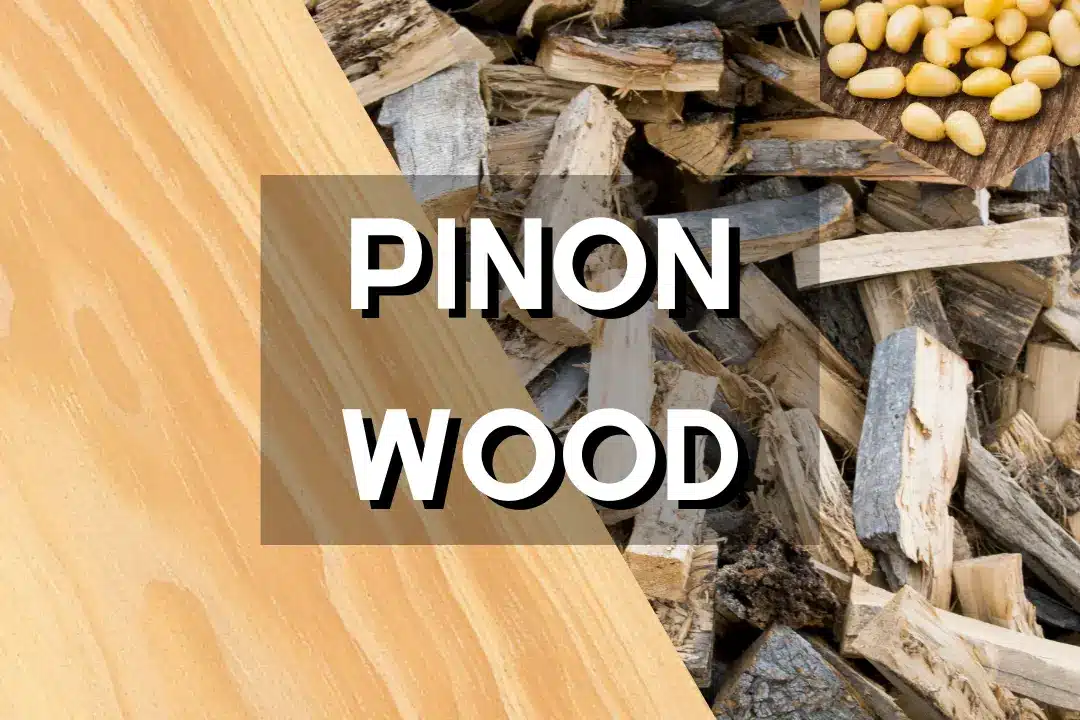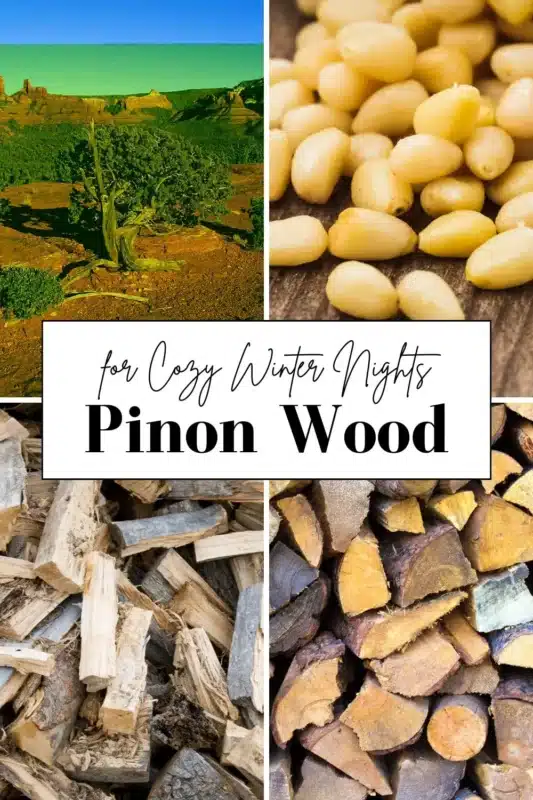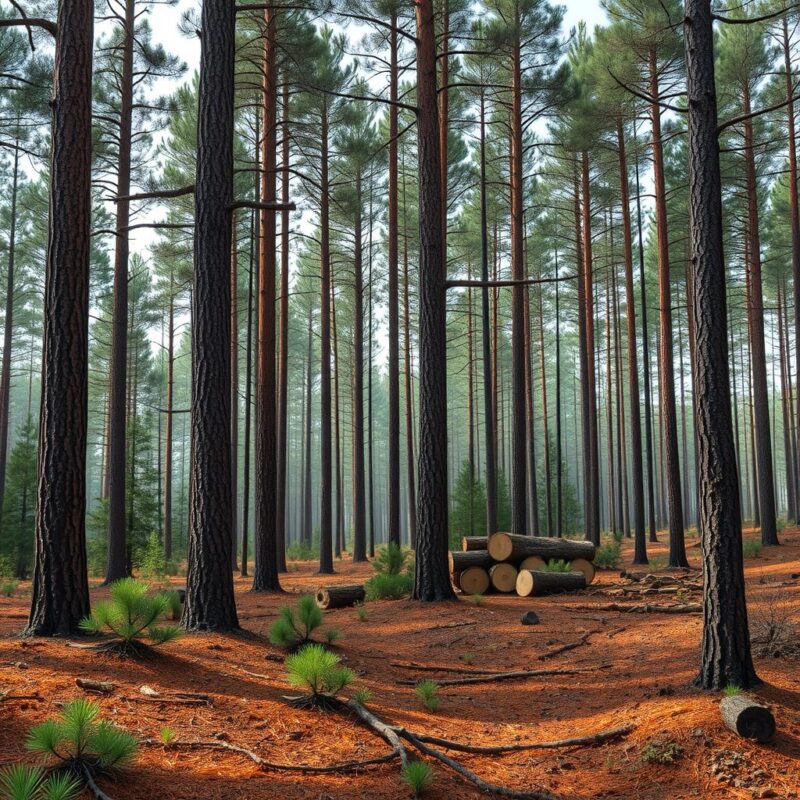
Did you know over 80% of the world’s forests have been lost? This shows how important it is to use natural resources wisely. Pinon wood comes from strong pinyon pine trees in the southwestern United States. It smells great and heats well, making it perfect for cold winter nights.
This article will dive into what makes pinon wood special. We’ll look at how it keeps us warm in winter and its role in nature. Learning to use this firewood right helps us care for the environment. It shows how we can live in harmony with nature.
Table of Contents
What is Pinon Wood?
Pinon wood comes from the pinyon pine, mainly Pinus edulis. It’s known for its special qualities and uses. These trees have edible seeds called pine nuts, making them important in nature.
Learning about the geographic distribution of pinyon pine helps us appreciate this natural treasure more.
Overview of Pinon Trees
Pinyon pine trees grow to be 30 to 50 feet tall. Their trunks are 1 to 2 feet wide. They weigh about 37 pounds per cubic foot.
Their wood is strong, with a Janka hardness of 860 pounds per square inch. This shows how durable it is.
Geographic Distribution
Pinyon pine trees are found in the Southwestern United States and northwestern Mexico. They love rocky, dry soil and thrive at high altitudes. Places like Utah, Colorado, and New Mexico are perfect for them.
These trees support a wide range of wildlife. This makes pinyon forests very important.
| Tree Characteristic | Description |
|---|---|
| Height | 30-50 ft (9-15 m) |
| Trunk Diameter | 1-2 ft (0.3-0.6 m) |
| Average Dried Weight | 37 lbs/ft³ (595 kg/m³) |
| Specific Gravity | 0.50 – 0.59 |
| Janka Hardness | 860 lbf (3,830 N) |
| Common Uses | Firewood, charcoal, pulpwood, utility lumber |
| Sustainability Status | Least concern (IUCN) |
Features of Pinon Wood
Pinon wood is known for its unique qualities. It has a special look and is very durable. Knowing about this firewood can help you see its value for different projects.
Appearance and Characteristics
This firewood has a warm, yellow-brown color. It has a fine to medium texture, making it smooth after sanding. The grain patterns are unique, adding beauty to each piece.
This wood is not just pretty. It’s also versatile for home decor, furniture, and cabinets.
Density and Durability
Pinon wood is dense, making it very durable. It’s strong but light, weighing about 37 lb/ft³. This makes it great for both inside and outside use, but it needs protection from decay.
It’s not the most durable wood, but treating it can help. This treatment can fight off pests and make it last longer.
| Property | Green | Ovendry |
|---|---|---|
| Specific Gravity | 0.50 | 0.53 – 0.57 |
| Weight | 51 lb/ft³ | 37 lb/ft³ |
| Modulus of Elasticity | 650,000 lb/in² | 1,140,000 lb/in² |
| Hardness | 600 lb | 860 lb |
| Durability Rating | Not Durable | Treated for Decay Resistance |
Knowing about pinon wood’s features is key. It’s beautiful, dense, and durable. This makes it a great choice for many projects.
The Benefits of Using Pinon Wood
Pinon wood is a great choice for anyone looking to improve their wood-burning experience. It offers many benefits, like a nice natural smell and being good for the environment. These reasons make this unique wood a top pick for firewood lovers.
Natural Aroma and Fragrance
Pinon wood is known for its lovely scent when it’s burned. This smell comes from its resin and smells like pine. It makes any room feel cozy and welcoming, perfect for cold weather.
Using this unique wood also makes outdoor events and cooking better. Chefs and outdoor cooks love it because it adds a special flavor to food.
Eco-Friendly Aspects
Using pinon wood is also good for the planet. It’s harvested in ways that protect forests. This is different from other woods that might harm forests.
Choosing this firewood helps forests stay healthy and safe. It also makes fires cleaner, which is safer for everyone. Firewood fans like these benefits a lot.
| Feature | Benefits |
|---|---|
| Natural Aroma | Enhances ambiance in indoor and outdoor settings, adds flavor to grilled foods |
| Eco-Friendly | Harvested sustainably, minimizes environmental impact |
| Burning Efficiency | Produces minimal ash, reduces cleanup time |
| Insect Repellent | Resinous nature deters insects, improving outdoor experiences |
| Safety | Reduces creosote buildup, lowering chimney fire risks |
Pinon Wood for Winter Warmth
Pinon wood is a top pick for keeping warm in winter. Its special burning traits make evenings cozy. Knowing about pinon wood’s features can make your home warmer and more efficient.
Burning Characteristics
Pinon wood lights up quickly and burns steadily. This creates a warm flame that’s perfect for any occasion. It has low moisture, which means it burns well and efficiently.
Its high BTU output is a big plus in cold weather. It heats up your space without much effort.
Heat Output Comparison
Pinon wood stacks up well against other hardwoods like oak and hickory. Here’s a look at how it compares in terms of price and heat:
| Wood Type | Stacks Price | 1/4 Cord Price | 1/2 Cord Price | Full Cord Price |
|---|---|---|---|---|
| Pinon | $65 | $280 | $485 | $950 |
| Oak | $45 | $175 | $320 | $590 |
| Hickory | $55 | $190 | $360 | $690 |
| Pecan | $50 | $180 | $345 | $675 |
This table shows pinon wood’s great price and heat output. It’s a top choice for keeping warm and cozy in winter.
How to Source Quality Pinon Wood
Finding quality pinon wood means working with reliable suppliers who care about the environment. These suppliers manage pinyon forests well. This helps keep nature rich and gives us good wood.
Choosing Sustainable Suppliers
When looking for pinon wood suppliers, make sure they care about the planet. Look for these signs:
- They use forests that grow back quickly.
- They handle the forest in a way that’s good for the earth.
- They make sure the wood is top-notch, so you can trust it.
- They check each piece of wood carefully.
Signs of Quality Pinon Wood
Knowing good pinon wood takes some clues. Watch for these:
- The wood looks the same, showing it was picked with care.
- It’s dry, so it burns well and doesn’t make too much smoke.
- It smells nice, which means it’s fresh and not rotten.
- It has a lot of resin, which means it lights up fast and heats well.
Quality pinon wood burns long and clean. It gives off a lot of heat and doesn’t leave much ash. This makes it perfect for keeping warm at home or in emergencies.
| Quality Indicators | Description |
|---|---|
| Uniformity | Consistent size and shape across pieces |
| Dryness | Absence of moisture for optimal burning |
| Aromatic Scent | Indicates freshness and lack of decay |
| Resin Content | High resin correlates with better ignition and heat |
Caring for Your Pinon Wood Supply
Keeping your pinon wood in top shape means knowing how to store it right and watching its moisture levels. Good care helps your wood stay ready for those cold winter nights.
Proper Storage Techniques
Choose a dry, well-ventilated spot for storing wood. Don’t put it on the ground, as it can soak up moisture. Use wood racks or pallets to let air flow. This keeps the wood dry and prevents mold, making it last longer.
Moisture Content and Drying Methods
this wood needs to be dry, around 20% moisture or less, for best use. You can dry it using different methods. Let it air out by stacking it right and exposing it to air for months. Use a moisture meter to check its dryness and make sure it’s ready for burning.

Pinon Wood in Traditional Customs
Pinon wood traditions hold deep cultural significance for Native American communities, mainly in the Southwest. This tree has been a source of food and support for thousands of years. It plays a key role in their customs and practices, honoring their native heritage.
The history of this wood is rich, involving not just nut harvesting but also community efforts. These efforts are crucial for preserving these traditions.
Cultural Significance
The piñon nut has been vital for Native American peoples for over 10,000 years. Early inhabitants of the Great Basin, dating back to around 12,000 years ago, relied on their environment’s resources. To Indigenous tribes, pinon and its nuts represent resilience and a deep connection to the land.
- Pine nuts are harvested through collective efforts, mainly from late summer to fall.
- This harvesting period is a significant social gathering, marking an important time for families and communities.
- Processing the harvested pine nuts involves multiple steps, showcasing the intricate techniques passed down through generations.
- Trementina, extracted from pinon wood, serves as a traditional remedy, highlighting the tree’s multifunctional value.
In New Mexico, piñon trees have supported local populations for centuries. Families gather hundreds of pounds of nuts in just a few days. This practice not only sustains their diet but also preserves their connection to the land and nature’s seasonal rhythms.
As modern challenges grow, preserving pinon wood traditions is key to maintaining cultural identity.
| Tradition | Description | Cultural Role |
|---|---|---|
| Pine Nut Harvesting | Collective gathering of nuts during late summer to fall. | Sustenance and community bonding. |
| Processing | Involves roasting, cracking, and grinding nuts into flour. | Preservation of traditional culinary practices. |
| Trementina Use | Extraction for ointments and painting preservation. | Demonstrates practical applications of natural resources. |
The high BTU content of dry, aged piñon wood is valued for heating. It’s also cherished for its distinctive fragrance, making it a popular choice for traditional stoves in Northern New Mexico. The connection between the tree and cultural practices highlights the importance of conservation and respect for the land. This is vital in maintaining the legacy of native heritage in the face of contemporary challenges.
Environmental Impact
The way we harvest pinon wood affects our forests and wildlife. We must find a balance between taking wood and keeping nature healthy. By harvesting wisely, we can protect trees and their homes for future generations.
Responsible Harvesting Practices
Good harvesting means taking care of our forests. We use methods like selective logging to keep the forest diverse. This way, trees can grow back and soil stays healthy.
Impact on Local Ecosystems
Bad harvesting can harm our forests and wildlife. It can make the land bare and cause erosion. Animals and plants that live there suffer.
Livestock can also damage the soil, making it hard for water to stay. This leads to more water running off. And, new plants that shouldn’t be there can grow, making it hard to fix the damage.

| Impact | Responsible Practices | Unsustainable Practices |
|---|---|---|
| Soil Quality | Improved through minimal disturbance and regeneration | Decreased due to compaction and erosion |
| Biodiversity | Enhanced through selective logging and habitat preservation | Reduced habitat for native species |
| Water Retention | Promoted by maintaining vegetative cover | Impaired by vegetation removal and erosion |
| Invasive Species | Control and management to protect native flora | Facilitated spread due to disturbances |
Pinon Wood: The Natural Wonder for Cozy Winter Nights
Many people love their pinon wood experiences in winter. A crackling fire warms not just the body but also brings people together. It’s a time for making memories and sharing stories by the fire.
Personal Experiences and Anecdotes
Stories about cozy winter nights show how special this wood is. Families talk about how its scent fills their homes, creating a cozy feeling. It brings back memories, making every moment special, like during holidays.
- Gathering around the fireplace with hot beverages in hand.
- Listening to stories passed down through generations.
- Enjoying the rich aroma that enhances the cozy atmosphere.
Every crackle of pinon wood brings back laughter and joy. People share how this wood is more than just heat. It’s a way to connect and strengthen relationships.
This wood is a treasured part of winter for many. It adds warmth and invites people to gather, making winter nights cozy and memorable.
Conclusion
Pinon wood is a standout resource that makes winter nights cozy and supports green practices. Its unique smell and high heat efficiency make it perfect for warmth in cold months. It also helps us live more eco-friendly, caring for our planet.
Its cultural importance and history add to its charm, making it more special to us. Learning about pinyon-juniper systems in the western U.S. shows us how to use it wisely. This way, we can keep enjoying it for many winters ahead.
Using this firewood means enjoying a warm winter and helping the environment. It connects us to nature and encourages us to live more mindfully. This wood is a treasure that brings us closer to the earth.
FAQs
What are the main characteristics of pinon wood?
Pinon wood is known for its rich, warm color and unique grain patterns. It also has a fine to medium texture and is very dense and durable. This makes it great for furniture and cabinetry.
How does pinon wood compare to other firewood for heating?
Pinon wood lights up quickly and burns steadily, giving off lots of heat. It’s as good as oak and hickory for heating. Its high BTU output is perfect for keeping warm in cold weather.
Can pinon wood be used sustainably?
Yes, pinon wood can be harvested sustainably. This means managing forests well to protect wildlife and prevent over-harvesting. It keeps ecosystems healthy.
What should I look for when selecting quality pinon wood?
Choose this firewood that looks the same, is dry, and smells sweet. These signs mean the wood is good quality and free from mold or decay.
How should I store pinon wood to maintain its quality?
Keep this wood in a dry, airy place to avoid moisture. Use racks or pallets to improve airflow. Aim for a moisture level of 20% or less.
What cultural significance does pinon wood hold?
Pinon wood is important to Native American communities. Its nuts are a key food source, and the tree represents strength and connection to the land.
What environmental impact does harvesting pinon wood have?
Harvesting pinon wood responsibly can help ecosystems and wildlife. But, bad practices can harm habitats and soil.
How does pinon wood create a cozy atmosphere?
Burning pinon wood fills spaces with a lovely scent. It’s a favorite for making homes warm and welcoming during winter.





